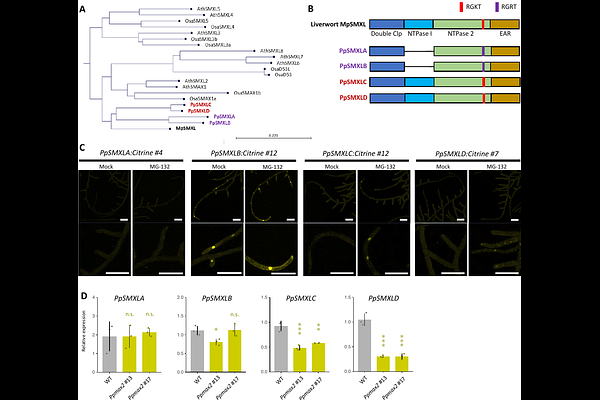MAX2-dependent signaling regulates the transition from 2D to 3D growth by suppressing cytokinin accumulation in Physcomitrium patens

MAX2-dependent signaling regulates the transition from 2D to 3D growth by suppressing cytokinin accumulation in Physcomitrium patens
Luo, Y.; Hata, Y.; Ohtsuka, J.; Komatsu, A.; Kojima, M.; Sakakibara, H.; Kyozuka, J.
AbstractPlants undergo distinct developmental phases throughout their life cycle. Proper regulation of the timing of phase transition in response to internal and external cues is crucial to optimize proliferation and reproduction. In Physcomitrium patens (P. patens), a moss, the transition from growth of filamentous tissue growth called protonema to gametophore bud formation represents a shift from two-dimensional (2D) to three-demensional (3D) growrh, ultimately leading to reproductive development. MORE AXILLARY GROWTH2 (MAX2), an F-box protein, targets repressor proteins in the KARRIKIN INSENSITIVE2 (KAI2)-dependent signaling pathway for degradation via the 26S proteasome-dependent pathway. KAI2 perceives an unidentified ligand known as KAI2 ligand (KL) as well as karrikins. The four SMAX1-LIKE (SMXL) family proteins work as suppressors in the MAX2-dependent signaling in P. patens. Gametophore bud formation was accelerated when MAX2-dependent signaling was disrupted, while it was delayed in Ppsmxls, loss of function mutants of the PpSMXLs. These results indicate that MAX2-dependent signaling suppresses gametophore bud formation in P. patens, which has not been previously described. We demonstrate that cytokinin activity and contents are increased in Ppmax2 mutants, and cytokinin application rescued the delay in bud formation in Ppsmxl mutants, suggesting that MAX2-dependent signaling suppresses cytokinin accumulation. The four SMXL genes redundantly act to promote gametophore bud formation; PpSMXLC and PpSMXLD, which contain the conserved degron sequence, act as the repressor of MAX2-dependent signaling, while PpSMXLA and PpSMXLB function independent of proteolysis-dependent signaling. Based on these findings, we propose that modulating cytokinin activity to control developmental phase transition may be a conserved role of MAX2-dependent signaling in bryophytes.